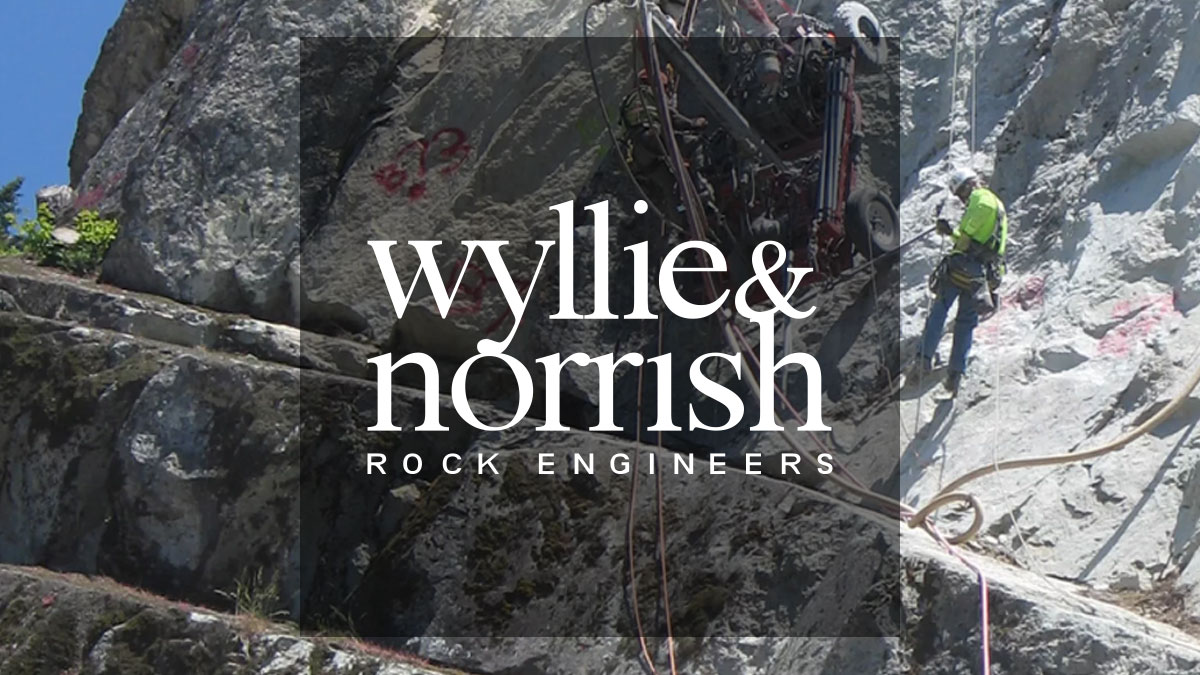
Application
Modeling rock fall masses, trajectories, velocities, and energies to design rock fall protection structures. Communicating risk to clients by calculating impact energy probability so that the impact capacity of the protection structure can be matched to the consequence of an accident.
Summary
Duncan Wyllie, a Principal of Wyllie & Norrish Rock Engineers, uses @RISK and PrecisionTree for probabilistic modeling of rock fall hazards. The analyses incorporate uncertainty in values of the mass and velocity that are expressed as probability distributions, and Monte Carlo simulation in @RISK is used to calculate the probability distribution of the impact energy. The energy calculations are then used to design protection structures such as concrete sheds and wire rope fences with the appropriate impact energy capacity to suit the possible consequences of an accident. Decision analysis using PrecisionTree is then applied to determine the optimum mitigation strategy.
In the example, Wyllie explains how Palisade software is used to calculate potential rock fall impact energies and make recommendations for a fence to protect traffic at the base of a steep mountain slope.
Background
Wyllie & Norrish Rock Engineers, with offices in Seattle and Vancouver, Canada, is a specialist engineering company working in the fields of rock slopes, tunnels, blasting, foundations, landslides, and rock falls. Duncan Wyllie and Norman Norrish, the company principals, have a combined total of 80 years of experience in applied rock mechanics.
Since the 1990s, Wyllie and Norrish have been utilizing Palisade software to analyze rock fall risks and hazards, and design rock fall protection structures. They provide hazard mitigation services for rock falls in mountainous areas by identifying rock fall sources, modelling rock fall trajectories and energies, and designing customized protection structures. Projects have been undertaken for highways, railways, hydro-electric power plants, and residential developments.
Using Palisade Products
For most rock fall projects, very limited, or no, information is available from previous events. In these circumstances, uncertainty exists in the design parameters of rock fall frequency, mass, velocity and trajectory. These uncertainties can be quantified using @RISK to define probability distributions that account for the possible range of values, and the most likely values, based on judgement and experience.
Wyllie found that the BetaGeneral and Pert distributions incorporated in @RISK provide the optimum models for these conditions. Multiplication of mass by the square of the velocity distributions gives the impact energy that is also defined by a probability distribution. This information can be used to design protection structures that reduce the hazard to an acceptable level of societal risk.
Another component of risk management for rock fall projects is to implement decision analysis in which alternative courses of action, such as construction of a high strength containment fence or of a less expensive ditch, can be compared. This analysis can be carried out using PrecisionTree in which the sum of construction costs and expected value of an accident (i.e., the product of an accident cost and its probability) can be compared for each course of action. PrecisionTree allows rapid analysis of these alternatives and incorporates sensitivity analyses that show how uncertainty in values of the costs and probabilities influence the selection of the optimum action.
A particular value of analyses using @RISK and PrecisionTree is that it is possible to define low risk but high consequence events that have a low expected value, such as a large-scale landslide. Comparison of this event with more frequently occurring, but less costly rock falls will show if the optimum mitigation measure is to stabilize the landslide or contain the rock falls. The analyses often show that very rare events are acceptable.
Duncan Wyllie
Principal of Wyllie & Norrish Rock Engineer
Rock Fall Modeling Example
When a rock fall source on a steep mountain slope was identified above a road, Wyllie used @RISK to calculate the probability distribution of the potential rock fall impact energies that would be used to design a protection structure. Because the site had no history of rock falls that could be used for design, @RISK was used to analyze the geology and empirical equations for velocity to develop BetaGeneral distributions for the mass and velocity, from which the distribution for the impact energy was calculated. These plots are shown below where the maximum, minimum, and mean values for mass, velocity, and energy are indicated.
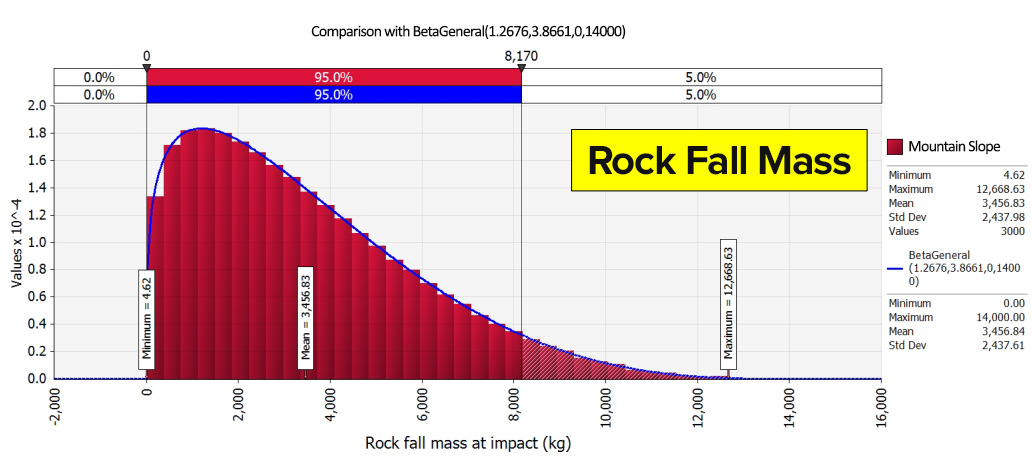
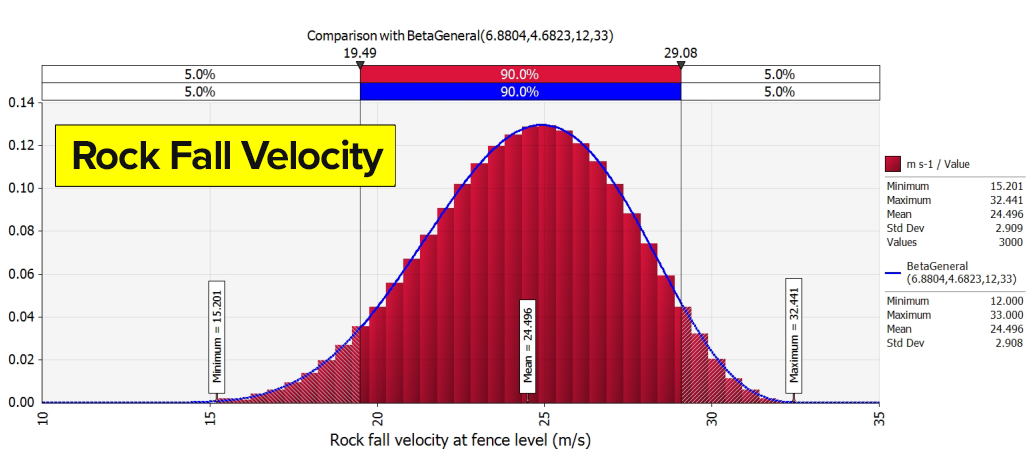
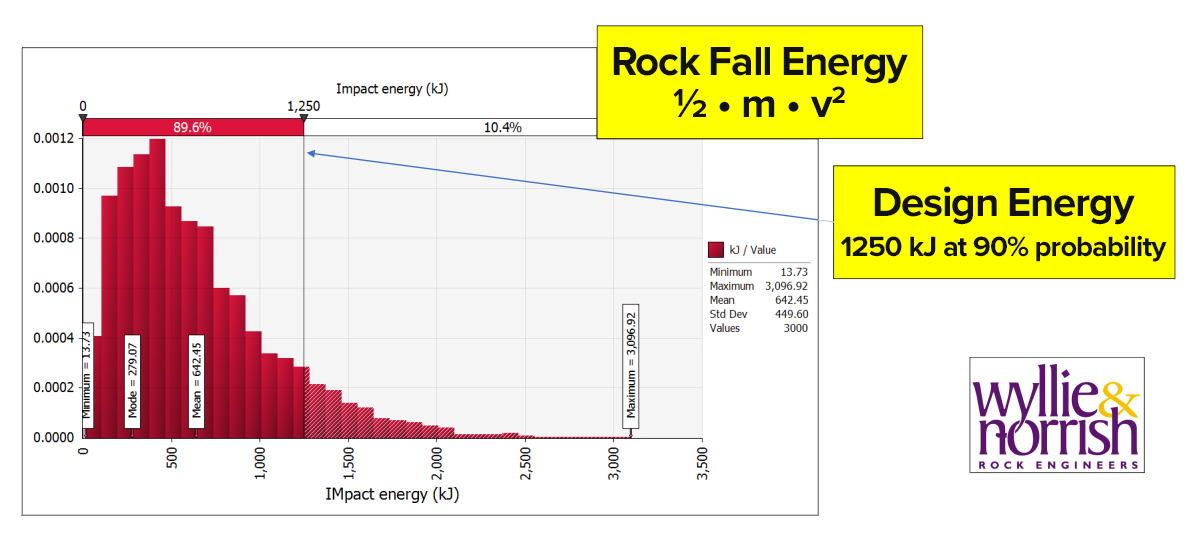
These results were discussed with the owner to determine an appropriate design energy capacity for a fence to protect the road from rock falls.
“Because access to the road was restricted and traffic was infrequent, it was decided that a rock fall event with high energy but low probability was acceptable,” said Wyllie. “The design energy of 1250 kJ was selected such that about 90% of falls would be contained, with the understanding that the low probability of an event with an energy exceeding 1250 kJ was acceptable.”
The image below shows the installed Attenuator fence.
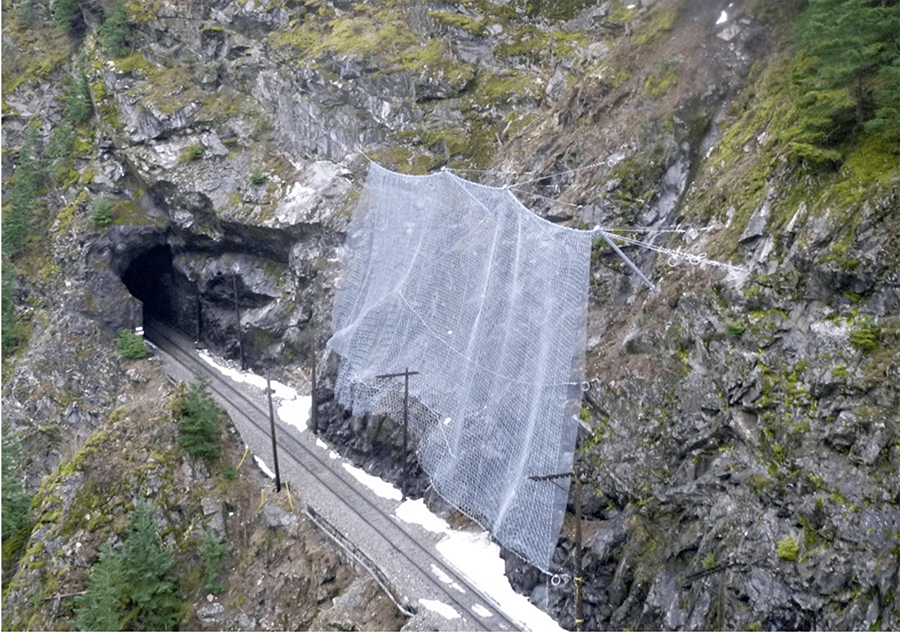
In comparison, if the fence was installed above a busy Interstate highway where the consequence of a high energy rock fall event could be severe, it is likely that the design energy would be about 2500 kJ to 3000 kJ to ensure that almost all rock falls would be contained.
“If we use @RISK and PrecisionTree to present results, people can make rational decisions as to what structural protection to install,” said Wyllie.
Results
Thanks to the probabilistic analysis conducted by Wyllie, the road has a fence in place that can withstand an impact energy of 1250 kJ that will contain about 90% of future rock falls. Those traveling on the road can have peace of mind knowing the hazard mitigation structure was designed through quantitative analysis.
A Competitive Edge
The use of @RISK and PrecisionTree software to prepare designs where many or all of the design parameters are uncertain allows Wyllie to quantitatively determine the best mitigation strategy.
With Palisade’s products, Wyllie & Norrish Rock Engineers can:
- Calculate all possible scenarios with Monte Carlo simulations
- Easily communicate risk to clients with PrecisionTree
- Recommend defensible hazard protection strategies.
By using deterministic analysis, Wyllie & Norrish Rock Engineers ensure that effective hazard mitigation structures are in place to protect people, facilities, and infrastructure.
